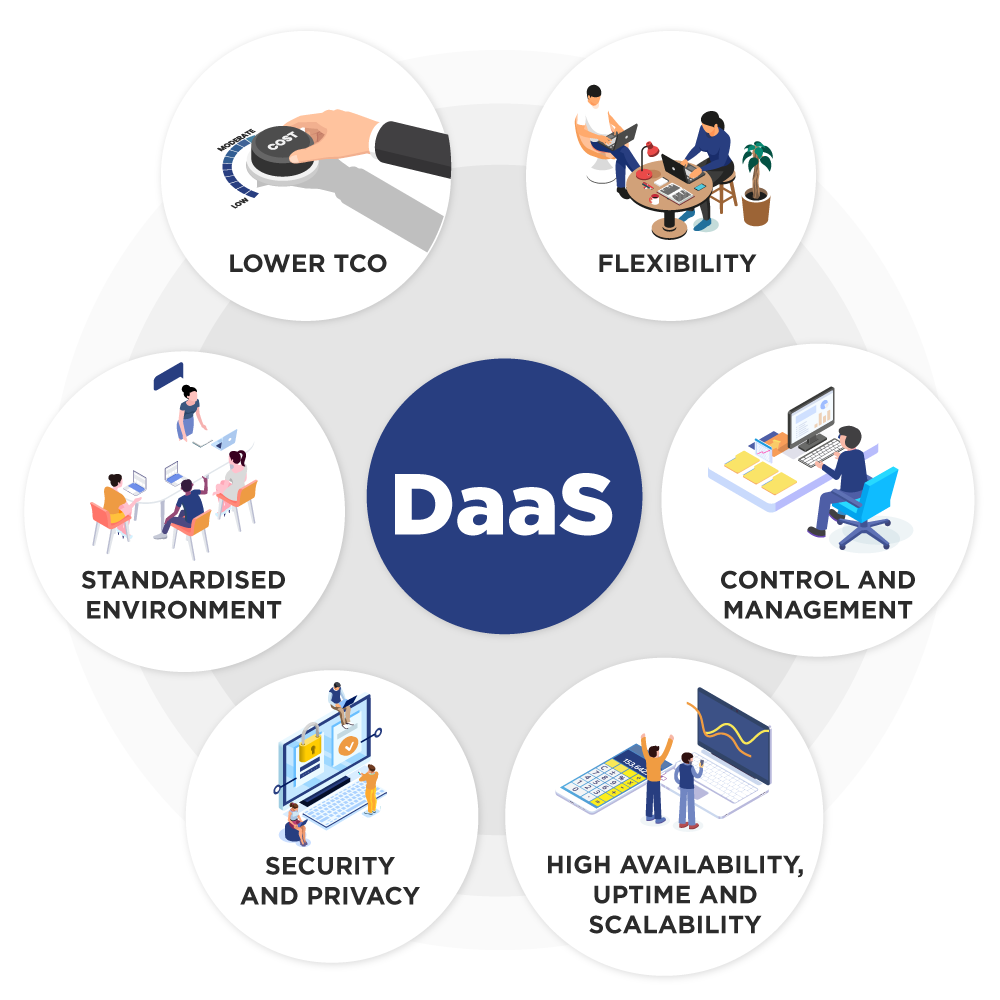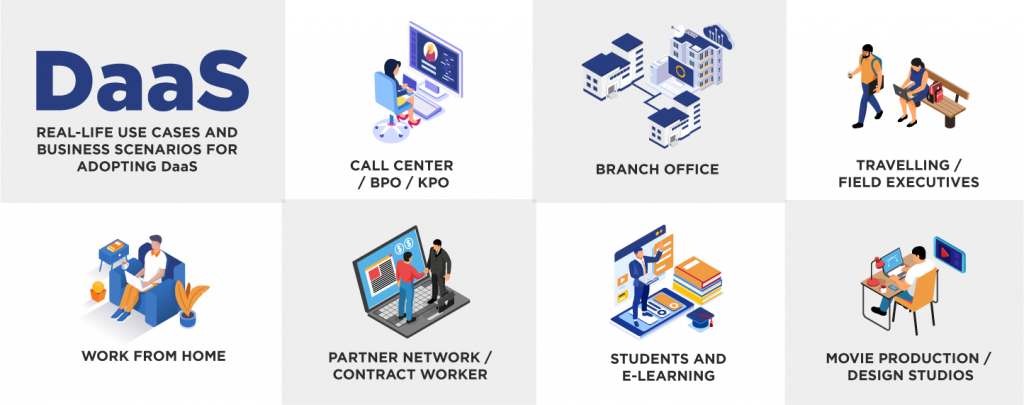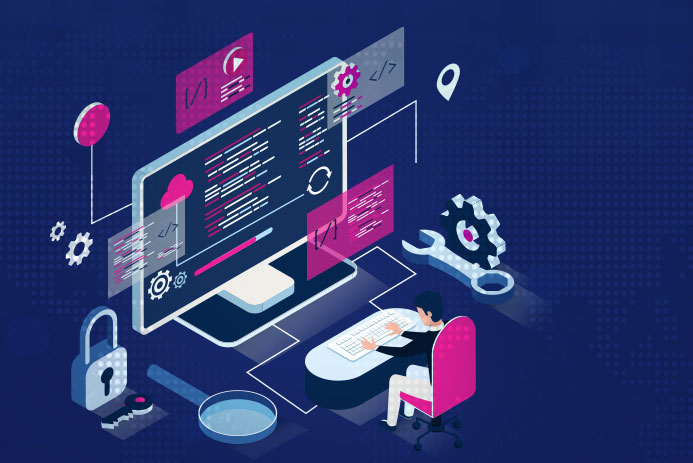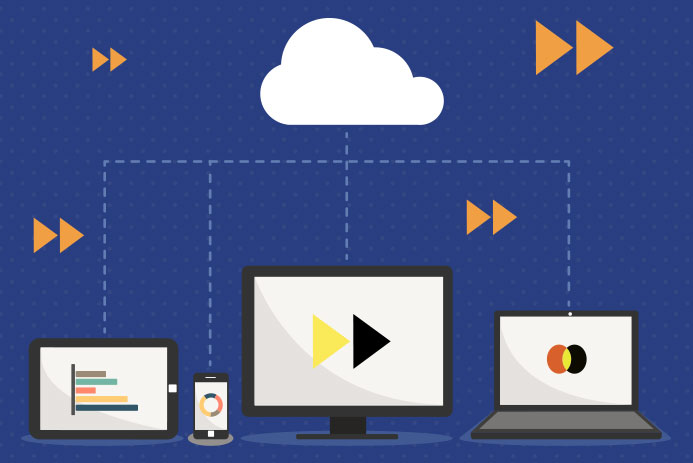As per a recent Economic Times article, more than 50% employees of India Inc. will continue to work from home even when the global pandemic is over. With remote working becoming the new norm, employees either are using company-provided laptops, personal PCs, and Internet connectivity. However, these endpoints pose a security risk – it is not a good idea to put copies of corporate data on employee laptops. That is why organisations are increasingly opting for VDI (virtual desktop infrastructure) solutions.
VDI is a service where the desktop is hosted on a central server. Client devices such as thin clients, terminals, laptops, tablets, and mobile phones access virtualised desktop images on the server. The data and documents that the user generates are stored on the server, and not on the client devices.
DaaS (Desktop-as-a-Service), is a type of VDI provided by cloud service providers (CSPs). All desktop images from various clients are managed by specialised software such as a connection broker and a hypervisor on the central server in the data center.
DaaS is a cost-effective and secure VDI solution that presents myriad cost savings and flexibility. The demand for DaaS (and cloud services) has soared in the wake of Covid-19 and remote working. Let’s take a look at some of the benefits of DaaS and its various flavours.
Benefits of DaaS

Business models are changing, and a distributed work environment is becoming the norm. Enterprises want to provide scalable, secured, and flexible access to data, applications, and content to their employees, across devices and locations. At the same time, they are looking for lower costs/TCO, agility/flexibility, and productivity. With DaaS, an organisation is assured of business continuity, while its data remains safe.
Lower TCO : An organisation typically owns hundreds of laptops/desktops. A lot of CAPEX is incurred to procure, both hardware and software. Besides, there is always the issue of hardware getting obsolete and stuck with a lower version of the software. To maintain and manage these, the organisation’s IT department needs a lot of resources. With DaaS, it is the responsibility of the CSP to upgrade, maintain and secure desktop images. The cost of bandwidth, software licenses, security, and maintenance are all bundled into the cost of the service. This translates to the lower total cost of ownership and provides the CIO/IT head with predictable cost.
Standardised Environment : Since everything is managed centrally, there is the benefit of using a standard operating system and applications. There is a cost-benefit of buying software licenses for all users in bulk, rather than independently for each client.
Security and Privacy : Data does not reside on the client, so it cannot be copied or transferred to another device. It is stored securely on a central server.
Flexibility : DaaS provides flexible working scenarios such as ‘work-from-home’ or ‘hot-desking’ – a concept wherein multiple employees share the same physical workstation/desk and computing resource during different periods or shifts. In this case, they could share a desktop image at different times, thus saving costs.
Control & Management : The CSP manages desktop images, security, and compliance. That means improved business continuity, reliability, and data integrity.
High availability, uptime, and scalability : The CSP will ensure maximum uptime, and that means high availability of resources and minimum downtime. This is backed by SLAs. The infrastructure can also be scaled up or down, on-demand.
Types of desktops
In a DaaS setup, there is no one size fits all approach. The solutions are customised as per the requirements of users/businesses. There are four broad types of usage scenarios:
- Desktop for Consumers/Students – Those who use DaaS at home for personal applications like browsing, learning, video chats, watching videos, playing games, using photo editing/video editing, drawing, etc.
- Desktop for Business – They use email, create documents and spreadsheets, research on the Web, or view PDF documents. Also, they use enterprise apps like ERP, CRM, HR apps, etc.
- Desktop for Graphic intensive tasks – These users are designers who use apps like CAD, design applications, and video/photo editing tools. These are all processor and graphics-intensive tasks that require more computing power.
- Desktop for AI/ML users – These users need to run analytics applications to process vast amounts of data. This is also a processor-intensive task which requires beefy hardware.
Real-life use cases and Business scenarios for adopting DaaS

DaaS can be used in various industries and for multiple types of users. Some of the business use cases are listed below:
Call Center/BPO/KPO – In this industry, data is sensitive and includes customer profiles, credentials, credit card information, and transactional data. DaaS can provide a high level of data security.
Branch office – Banks are opting for DaaS for their branches and also for employees who work from home. CSRs (customer service representatives) working from remote locations need to access customer records stored on the central server; this makes it safe and secure for the businesses as well.
Travelling/Field executives – Organisations are encouraging travelling executives and sales staff to use thin clients, tablets, and mobile devices. These are lighter and pose little risk if they are damaged or misplaced since the data is not stored on these devices. Besides, they can access data in real-time on the move.
Work from home – With the global workforce now working from home, it makes perfect sense for them to use DaaS instead of laptops. For organisations, they can have better control on accessibility to data and can also avoid data breaches.
Partner network / Contract worker: DaaS is also suitable for external entities like business partners, contractors, or dealers who connect to an enterprise network. It’s ideal for dealer management systems.
Students and e-learning: Those who work on projects for a limited period can use a DaaS instead of a high-end laptop. DaaS is suitable for e-learning platforms because of the standardisation of software and bundled licenses.
Movie production/design studios: Instead of investing heavily in high-end workstations, studios will benefit from the lower TCO provided by DaaS solutions. Moreover, if it’s a project-based output, they benefit from the pay-per-use model.
Tips on selecting the right type of DaaS service provider
If you have decided to opt for DaaS, the next step is to select a service provider. Do your due diligence and compare pricing and features among various service providers. And remember, as mentioned earlier, there is no one size fits all approach. DaaS offerings can be tailor-made for your business; one can also select applications and instances that need to be provided on DaaS.
Look in for the below features from your DaaS service provider :
- Pay-as-you-go and transparent pricing with no hidden or incremental costs
- Integration with third-party applications using API’s
- Integration with LDAP/AD. Replicate existing customer security policies in the data center
- Low-latency with Unlimited Data Upload/Download
- End-to-end security at each layer. Data encryption during rest & transit
- Supports both Windows and Linux architectures with embedded applications in a hosted environment
- Flexibility – organisations can continue using existing EULAs thereby saving costs when moving to the cloud
- Licenses available on a pay-per-use model
- Unified and simplified management of devices through a single layer of management console
- Rapid deployment and centralised management
- Support for hybrid VDI environments. Supports all four desktops on private or public cloud
Many DaaS or VDI solution providers do not bundle bandwidth costs; it is wise to clarify this point before signing the SLA. Besides, it is also equally important that the data center that the DaaS or VDI relies on is fault redundant, that is an Uptime Institute rated Tier IV data center. Tier IV is the highest quality for a data center infrastructure and ensures that your data is secure and workloads will continue to enjoy maximum uptime.

















 Back
Back







